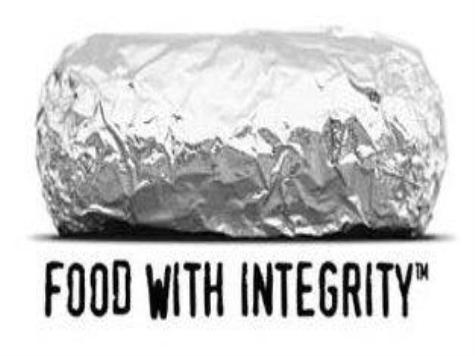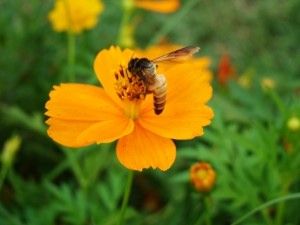Chipotle Leads Way in Sustainable Fast Food;
Expands Market for Naturally Raised Meats
By Melonie Magruder
August 6, 2013
In 1993, Steve Ells, a recent graduate of the Culinary Institute of America, had an idea for a restaurant that offered freshly made-to-order burritos, inspired by the neighborhood taquerias he frequented in San Francisco. He bought an old Dolly Madison ice cream shop in Denver, Colorado, hired a staff, which developed a mean wrapping technique, and experimented with roasted corn salsas. Chipotle was a hit.
Twenty years later, Chipotle is a player on the New York Stock Exchange, has expanded to more than 1,400 restaurants and has redefined the usually pejorative term “fast food.”
“I wanted to elevate fast food,” Ells said. “The idea was that I could use these authentic ingredients, but then put my own twist on them.”
Ells trained as a chef, not as a businessman (“I was an art history major,” he said, dryly), so his aesthetic was geared more to taste than lowering the bottom line. But it’s a focus formula that works for Chipotle. In 1999 Ells learned a little about how most factory-farmed pork is produced (pigs kept in filthy, tiny cages leading to a terrifying end in processing) and vowed to change the purchasing practices for his business.
He started sourcing his pork through Niman Ranch, which allows its pigs to roam freely in grassy pastures. By 2010, 100 percent of the pork Chiptole served came from naturally raised farms. Today, 100 percent of the chicken Chipotle serves comes from farms that don’t treat with antibiotics and raise their poultry humanely.
Ells also made it a policy to source produce within 350 miles of the restaurant and buy as organic as possible. Today, 40 percent of their beans are organically grown, relieving the environment of some 140,000 pounds of chemical pesticide since 2005. As they say on their website, “We know it tastes better.”
Read more at Seedstock
Honeybee Colony Collapse: New Insights
By Noelle Swan
August 8, 2013
Researchers at the University of Maryland and the USDA uncovered several links in the chain of factors contributing to massive honeybee losses seen around the country.
Beekeepers have been reporting entire hive losses since 2006, when the media dubbed the phenomenon Colony Collapse Disorder (CCD). Several studies have pointed to poor nutrition, pesticide, pests, and pathogens; however, no single smoking gun has emerged.
“Increasingly we’re thinking it’s a combination of factors coming together and setting colonies up for decline,” said Dennis vanEnglesdorp, an entomology professor at the University of Maryland. “So we wanted to look at what pesticides honeybees are exposed to and what affect those pesticides have on their ability to fight infection of the fungal disease Nosema.”
Read more at Seedstock
The Art and Angst of Water in California:
Keeping It Flowing in Fair, Balanced Manner
By Trish Popovitch
August 1, 2013
With water, it’s soil. Without water, it’s dirt.” –Danny Merkley, California Farm Bureau
A symphony, a balancing act and an art form. These are just a few ways Danny Merkley, Director of Water Resources for the California Farm Bureau Federation, describes managing the flow of water in the Golden State. It’s been his job since 2007, but a love of water blossomed early in this fourth generation California farmer.
“Growing up on the ranch I ran a number of irrigation systems from surface irrigation systems, row systems to sprinklers to, in a small way, some drip systems early in the 1990s. Water to me is an art form; moving water across a field, across large acreages of land, across more than just a 20 foot front yard. I’ve always been fascinated with water, but water policy I accidentally walked into when I got bit by the water bug working at the state water board in 2004,” shares Merkley.

Irrigation canals crisscross the Imperial Valley, delivering Colorado River water that turns the desert into productive farmland. Photo/California Farm Bureau Federation
Merkley earned a degree in farm management and worked the land for 17 years. Realizing the relationship between agriculture and legislation, Merkley became involved in local politics. At one point he worked for Representative Dan Lungren of Gold River. He then joined the State Water Resources Control Board in 2004 acting as a liaison between farmers and the state. After becoming acquainted with the water issues facing California, Merkley moved on to the California Farm Bureau.
“The California Farm Bureau Federation is a federation, which in itself implies that we are truly a grass roots organization. We have 53 county farm bureaus. What I do is work with county farm bureaus and their membership to be certain that what I’m doing to advocate on their behalf is not negatively impacting another one,” explains Merkley. “They look to me, to my colleagues up here in Sacramento, for expertise and assistance at the state level. We look to them for direction on how they are impacted by a certain policy or a certain piece of policy, whether it’s legislative or regulatory,” concludes Merkley.
Understanding the water system of California is easier if visualized as three separate sections. Most water originates from the snow pack of the Sierra Mountains and precipitation found in the first section north of Sacramento. This water must then be distributed to the other two sections: the San Joaquin Sacramento Delta region (the middle or second section) and the far south (Los Angeles, San Diego and the surrounding farm land), or third section. Its Merkley’s job to make sure the water flows in a fair, balanced manner throughout the 58 counties so all of California’s 400 plus commodities can grow and thrive. Not an easy task with a tight budget and a 70-year-old inefficient water system.
“The system was built when we had 17 million people. We’ve got 38 million today (roughly). We’re expected to have 50 million by the year 2050,” states Merkley. The problem is obvious, but fixing it will take money and time as Merkley explains. “This is such a complex system; you don’t just upgrade it overnight. And if you have neglected it for decades it would be a herculean task to: 1. Get it done in a timely fashion now you are already behind the curve on it, and 2. Raise the capital funds to do that. The state is not in a position to fund it with general fund dollars even though much of the updates that are necessary are public benefit updates to help protect, improve and enhance the delta’s ecosystem.”
Read more at Seedstock
Arizona Researchers Compiling First High-Res Global Cropland Map
By Noelle Swan
August 13, 2013
A multi-disciplinary team of researchers scattered around the country is gearing up to piece together the world’s first high-resolution map of global croplands, in a cross-institutional collaboration. The team’s goal is to answer the question, “Where is all of our food going to come from when global population reaches 9 billion people?” Researchers hope that having a detailed picture of what’s happening with croplands around the world will help to inform the net effect of regional demographic and geological changes. Piecing together that accurate of a map will likely take five years, $3.5 million (funded by NASA), computation of thousands of satellite images, and collaboration with crop experts all over the globe.

Irrigated crop fields show up as red boxes on this satellite image of the Sonoran Desert. Image Credit: Northern Arizona University.
The project is the brainchild of Prasad Thenkabail a research geographer at the United States Geological Survey with expertise in both remote sensing and cropland mapping. While global agricultural production has kept pace with population growth since the 1960’s, “that is coming to an end,” Thenkabail says. “Now the lands are becoming limited, more and more are being taken up by urbanization, and still more is being taken away for ethanol. Water, too is becoming scarce. In order to figure out how to produce more food with less land and less water, we must be able to examine how we are currently using land and water, Thenkabail said. He expects that his global cropland map will be able to provide that information.
Read more at Seedstock




